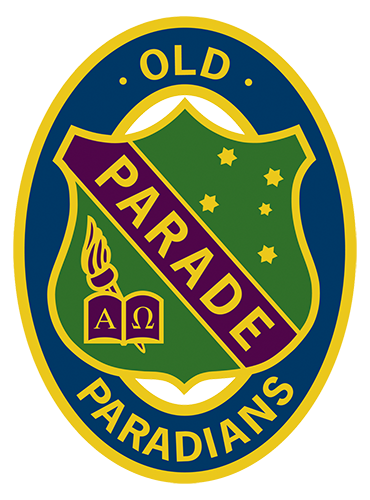

In July this year, Old Paradians Central took a phonecall from the Sydney-based writer and researcher Michael Adams.
Michael was seeking any information and/or images from the College’s
archive in respect of the final year student of 1910, Michael (‘Mick’)
Maguire.
The association, through the college archivist Rodney Prusa, was able to assist with a superb image of Parade’s 1st XVIII team of that year, with captain Mick Maguire appearing in the centre of the middle row. Third from the right in the back row is Tom Wellington, the Champion Victorian Schoolboys athlete.
Mick was central to a schoolboy football outfit that took on all comers – Haileybury, South Melbourne, Caulfield, Brighton and St Thomas’ - with ease. To quote The Paradian correspondent;
The Parade boys had figured very prominently in football up to 1909, but for 1910 all schools had to yield the palm of victory to us, for we went through the season without a single defeat, and secured the proud title of champions. We met each team of the secondary schools association in turn, and improved on our scores at each match.
Mick was part of a Parade fraternity that included 1910 College dux Norman O’Bryan (later Sir Norman, a great legal figure in Melbourne). Brian Rush (whose brother Bob’s name is synonymous with Collingwood) earned Honours in British History, while Gerald Doyle (later a surgeon of renown) also excelled academically.
Another academic achiever of 1910, Leo Basto, was later killed at the Gallipoli landing.
As a former VFL footballer – one of the select group of more than 100 ex-Parade, Mick’s name was known to the Old Paradians’ Association.
But as the Sydney-based author Michael Adams writes, Maguire’s later life (and those of his wife and daughters for that matter) is truly the stuff of Hollywood legend.
REMEMBERING MICK MAGUIRE
Few characters had bigger or more colourful lives than Mick Maguire. Born in 1894, he not only captained the CBC Parade East Melbourne football team in 1910 but that same year, aged just 15, made his VFL debut for Richmond. He was the team’s leading goalkicker in that year and the next.
In 1912, the Old Paradian defected to Melbourne, playing for them until early in the 1914 season. By then Mick, whose dad Michael had been a bareknuckle fighter, was a rising boxing star, promoted by Snowy Baker.
Towards the end of the war, with his younger brother Andy eclipsing his achievements in the ring, Mick and his wife Mary (known to family and friends as ‘Biner’) embarked on a career as publicans, taking over Northcote’s Carters Arms Hotel. The hotel, which stood on what is now the Northcote Central Shopping Centre on the corner of High and Separation Streets, was demolished in 1989.
By the mid-1920s Mick and Biner were well known through Melbourne as proprietors of the Bull & Mouth in busy Bourke Street. Their five daughters were young beauties enrolled at the Academy of Mary Immaculate, with Biner declaring she wanted them all to marry millionaires.
In 1932, as proprietors of the Metropole Hotel, the Maguires hosted film people, including George Wallace, then making movies for Frank Thring. One of these stars, June Mills, noticed Peggy Maguire, Mick’s second-oldest daughter, and she got a small role in 1932 Pat Hanna comedy Diggers In Blighty.
The family moved to Brisbane shortly after, taking over the historic Belle Vue Hotel and from then they increasingly moved in upper-class political and social circles.
In mid-1934 Peggy, just 15 years old, was cast as the female lead in Charles Chauvel’s epic Heritage, which was shot in Melbourne. Her next Australian film, 1936’s The Flying Doctor, saw her cast opposite Charles Farrell, a huge American talkie star.
Even before it was released, Peggy — now known as Mary — was summoned to Hollywood, with Mick going with her and acting as her manager. She scored a contract with Warner Bros., which led to the rest of the family moving to America in 1937 and Mary's sisters also getting film work.
Mary was a hit on the Hollywood social scene, befriending the likes of Ronald Reagan, Cary Grant, Howard Hughes, Bette Davis, Betty Grable, Marion Davies, William Randolph Hearst and 20th Century Fox head Joe Schenck, among many others.
Meanwhile, the Maguire mansion became a hangout for the girls’ young movie-studio friends, including the likes of Shirley Temple and Judy Garland. Ever the chancer, Mick offered his services as a fight consultant to the studios—and his opinion on the deficiencies of the American horse-racing scene at Santa Anita.
After appearing in six movies for Warner Bros. and 20th Century Fox, Mary moved to London, where she made more films, and set her family up in with a villa in Cannes. There, Mick and Biner hosted dazzling parties for the rich and famous.
Back in London, Mary made a fateful decision by marrying Robert Gordon-Canning, who, until recently had been foreign policy director in Oswald Mosley's British Union of Fascists.
Remarkably, when World War II broke out and the fall of France loomed, Mick, then 45, signed up for the BEF and found himself at Dunkirk, witness to Nazi atrocities before he was evacuated.
By the end of the war, Biner’s plan had come to fruition—all five of her daughters had married millionaires and/or aristocrats and moved in the upper echelon of British society.
While her sisters were feted, Mary’s star had faded by the time moved back to the US in 1945.
Mick died suddenly of a heart attack in London in 1950, with Biner passing away there in 1963.
Australia’s Sweetheart: The Life And Times Of Mary Maguire, Our Forgotten Hollywood Star will be published by Hachette in March 2019. Any Old Paradians with any information or stories about the Maguire family are urged to please contact Tony De Bolfo.
image of Biner, Mary, Mick and Lupe Maguire, circa 1936, courtesy Michael Adams